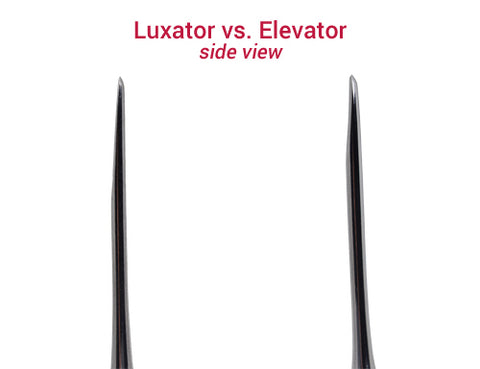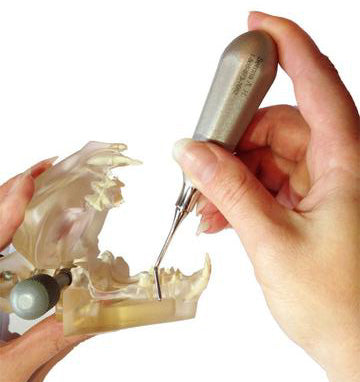- Receive an email notification when a new blog is released!
Elevator or luxating elevator; what is the difference? Both are designed to aid in the extraction of teeth, however, there are significant differences in their design and intended use.
If you compare an elevator and a luxating elevator from the side (as shown in the picture below), you can see they are different. Luxating elevators are thinner than traditional elevators, and because of this, they are sharper. Elevators are thicker with a slightly bowed shoulder on the back side and are less sharp.
Because luxating elevators are thinner and sharper, they are better able to fit in tight apical spaces and are more efficient at cutting the periodontal ligament. They are designed to be used in a circular cutting motion while applying apical pressure, to separate the tooth from the surrounding bone and periodontal ligament. You can also use a deeply wedged luxator to push against a tooth root to assist in tearing the periodontal ligament. Luxating elevators should not be used in a prying motion like traditional elevators, however, nor should you try and apply torque to a tooth root with a luxating elevator. When you use a luxating elevator as a wedge against a tooth to facilitate the breakdown of the periodontal ligament, the luxating elevator must be deeply seated in the periodontal ligament space. We often describe luxators as being a very technique sensitive instrument as they are not very forgiving and will chip and/or break if used incorrectly.
Traditional elevators are used in human dentistry to lever or pry teeth out of the socket. Although we don’t extract teeth in quite the same fashion in veterinary dentistry, elevators are still extremely popular and useful instruments. This is especially true in situations where more force and/or more torque is needed to extract a tooth. Although elevators aren’t as sharp as luxating elevators, they are stronger and more durable because the tips are thicker. Many practitioners use elevators to fatigue and tear the periodontal ligament rather than to cut it like you would with a sharp luxator. For these reasons, elevators tend to be a better choice for those less experienced in recommended extraction techniques.
Winged vs. Non-Winged Elevators
Many assume that if an elevator doesn’t have wings, then it must be a luxating elevator. Not so! While the most commonly used and recognized elevators in practice are winged elevators, non-winged elevators are also commonplace. The difference between the two can be seen in the picture below. The purpose of the wings is to hug the tooth root so you are less likely to slip and thus stay in the periodontal ligament space. When a winged elevator that is too large or the wrong shape is used to extract a tooth, the wings have a tendency to dig into and crush the surrounding alveolar bone, rather than work on the periodontal ligament. Whether you use winged elevators or non-winged elevators is a personal preference. Some practitioners say the winged elevators are their favorite's, while others prefer not to use them.
What should I use, a luxating elevator or an elevator?
Most veterinary practices have a number of elevators in their dental armamentarium. It’s less common for practices to have luxating elevators unless one or more veterinarians have taken some dental continuing education where they have been introduced to them. Which you should use is largely a personal preference, one that can be influenced by your method of extraction. Those that remove a lot of buccal bone and are fairly aggressive with their extraction technique tend to like elevators. Those that try to remove as little buccal bone as possible tend to prefer luxating elevators, as they need something sharp to cut the periodontal ligament. The most well equipped practices have a mixture of both types of instruments. The key is to ensure the instrument you choose fits the tooth root being worked on. Too large and it will crush the surrounding alveolar bone. Too small and it won’t be able to properly follow the curvature of the tooth root.
Choose an Instrument Based on the Anatomy
As mentioned above, it’s important to choose the correct instrument for the particular size and shape of tooth you are attempting to extract. You may need several instruments to extract one tooth. The root gets smaller as you get closer to the apex, so should your instrument. If your tooth root is curved, so should your instrument be. Trying to use a straight instrument tip on a tooth that’s curved can lead to a lot of frustration. While most practices have a selection of straight elevators and/or luxating elevators, they may not be aware that elevators and luxating elevators are available with different bends and curves. Luxating elevators have a subtle curve, while elevators have a more distinct bend to them. The bends and curves on these instruments allow you to gain better access to some tooth roots, and stay in the periodontal ligament space of any curved or angled roots.
Inward curved (IC) luxating elevators and inward bent (IB) elevators are designed to give you better access to mesial root surfaces, while outward curved (C or OC) luxating elevators and back bent (B) elevators will give you better access to distal root surfaces.
Some smaller sized luxating elevators are also available with the tip bent left (L) or right (R). These are intended to help the user better access the molars and premolars of cats and small dogs. They allow the instrument tip to properly fit into the periodontal ligament space, but keep the handle away from the opposing jaw, which can be a problem with smaller patients.
Troublesome Areas
If you find you have difficulty accessing any particular teeth or areas of the mouth with your current instruments, give us a call and we will be happy to find the instrument(s) that best suit your needs. Regardless of whether you use luxating elevators or elevators (curved, bent or straight), for your instruments to be most effective they need to be kept sharp, which is covered in our Dental Instrument Sharpening 101 article.
We hope that you have found this information helpful. If you have any questions or concerns regarding luxating elevators or elevators, please feel free to contact us for more information.


